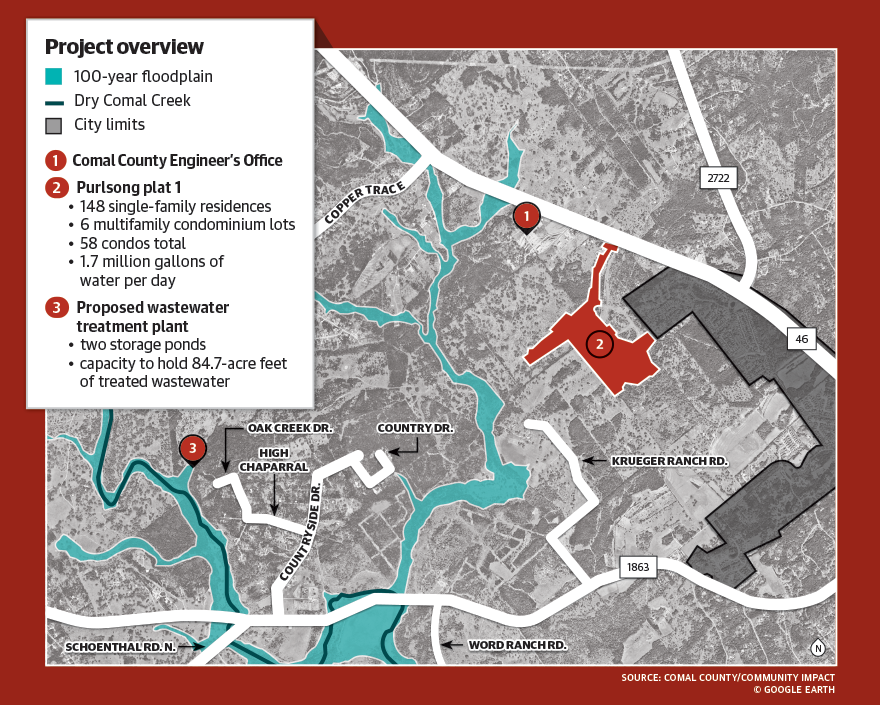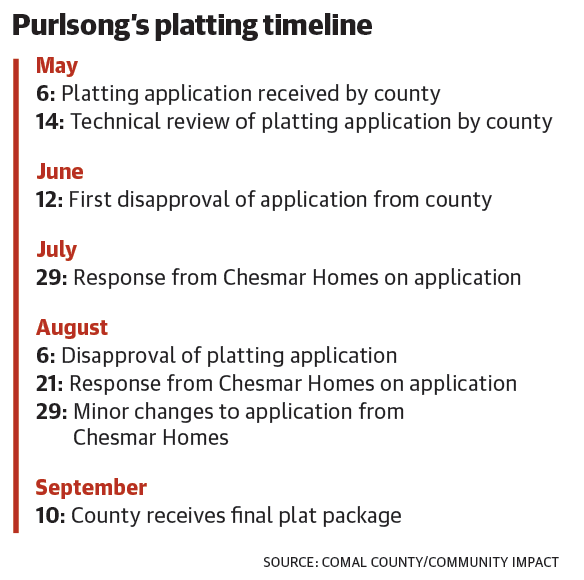During an Oct. 2 Texas Commission on Environmental Quality, or TCEQ, public meeting, Comal County residents spoke out against the submitted permit.
Purlsong is a mixed-use development that will consist of 148 single-family residences and six multifamily condominium lots for 58 total condos, according to Comal County Commissioners’ agenda documents. The final plat and two variances were approved by commissioners Sept. 25.
Variances are when a developer wants to stray away from county subdivision regulations. The county commissioners court must approve all variance requests, Comal County Engineer Robert Boyd told Community Impact.
The developer was granted a variance for their setbacks along with 50 feet of right of way instead of the county standard, which is 60 feet, Boyd said.
The permit is for a proposed wastewater treatment facility and disposal site located 3.5 miles west of the FM 2722 and Hwy. 46 intersection in New Braunfels, according to a news release from the Greater Edwards Aquifer Alliance, or GEAA. GEAA is a nonprofit that promotes broad-based advocacy for the protection and preservation of the Edwards Aquifer.
Two-minute impact
The wastewater permit application was received April 2, 2024. Treated wastewater would be stored in two storage ponds, with the capacity to hold 84.7-acre feet of treated wastewater, said Alfonso Martinez III, an environmental permit specialist with TCEQ, during the public hearing.
But residents are concerned about the plant’s ability to withstand significant flooding, which has historically occurred in the area.
Angela Allen, a New Braunfels resident and planning and zoning commissioner, said she was concerned about the floodplains surrounding the wastewater facility.
“If you look at the master plan that is on record, it does have a 100-year floodplain going through the south part of the wastewater treatment facility,” Allen said. “If you look at the whole master plan, the development surrounds the 100-year floodplain.”
Hayden Folks, a consultant for the applicant, said the plant would be located outside of the Federal Emergency Management Agency floodplain.
In the event of a rain event, the wastewater facility will not flood or discharge because it has 60 days of storage, JA Wastewater President Jamie Miller and a consultant on the project said during the hearing. There would also be generators at the facility to ensure it remains operational during a flood event.
“There are mitigation measures put in place so that the wastewater treatment facility—the water from that is being treated—doesn’t flood,” Miller said.
Helen Gilbert, an attorney with Barton Benson Jones, representing the applicant, said the discharge permit prohibits runoff, which is why the retention pond is “oversized.”
“Runoff is a problem for the applicant because it’s a violation of the permit. A violation of the permit results in a monetary penalty, injunctive relief [and] enforcement action by [TCEQ],” Gilbert said.
Part of TCEQ’s application review does not involve flooding. They only consider whether the facility is in the 100-year floodplain to ensure adequate protection, Martinez said.
If Chesmar and GBRA do not receive approval for the plant, then construction cannot start, Martinez said.

What the experts say
In an email to Community Impact GBRA said the proposed facility would use advanced membrane bioreactor, or MBR, technology and operate under a no-discharge permit. The plant would be used for irrigation within the development under a Texas Land Application Permit. The facility would expand the organization’s advanced treatment portfolio and purple pipe-reuse systems across the Guadalupe River Basin. GBRA does not operate any wastewater facilities that discharge into the Dry Comal Creek, or DCC, the email states.
The Purlsong development will be receiving water from Texas Water Company, or TWC. TWC announced in March that it will deny water service to nine planned developments across Comal County due to the state’s severe, prolonged drought and rapid population growth.
TWC said it has developed a dedicated water supply project in the region to support this previously contracted development.
TWC is also working on completing a long-range Water Availability Report, or WAR, which outlines how the company will meet future demand through groundwater, surface water and potential reuse strategies. The WAR directly supports the water supply planning for Purlsong.
The development meets all regulatory requirements of roughly 1.7 million gallons of water per day and is designed to support the community’s full build-out, the email states. As the project is built out, it will be subject to TWC’s Conservation Contingency Plan, which outlines responses to drought and peak demand conditions.
What residents are saying
Resident Leslie Campbell said putting a wastewater treatment plant “2 inches” outside a 100-year floodplain is too great a risk and that her well water comes up dirty after every rain event.
“I understand you’re sitting there saying, ‘Well, we’re outside the 100-year floodplain’—do better. As an engineer, do better. As a developer, do better. Come on, y’all. You may not be living there, but other people are,” Campbell said.
During the Sept. 25 Comal County Commissioners Court meeting, Dolores Patterson, a Comal County Estates resident—which borders Purlsong—said she was opposed to the entire development.
“The Texas Water [Company] may say they will provide water for this development, but they cannot adequately supply their existing customers less than 2 miles away in Rockwell Ranch,” Patterson said.

The catalyst
Two bills passed by legislators helped to pave the way for the proposed development.
Senate Bill 2038, passed by state lawmakers during the 88th legislative session in 2023, allows residents of an extraterritorial jurisdiction, or ETJ, to leave the city’s authority through a petition or election, as previously reported by Community Impact. ETJs were created by the Texas Legislature in 1963 and have allowed cities to invoke some regulatory authority over subdivisions outside of city limits to ensure those areas reflect the city’s development standards, said Bennett Sandlin, executive director of the Texas Municipal League.
During the 86th legislative session in 2019, the state legislature passed House Bill 3167, altering platting requirements for municipalities. The bill gives cities 30 calendar days to respond to plats, site plans and other development plans. These plans took 45-90 days to go through the approval process, according to previous reporting by Community Impact. The municipality approves a plat unless it is disapproved within the periods set by the bill.
“If Commissioners Court just said ‘We’re not [going to] take action on this,’ it would’ve been approved anyway because that’s the way Local Government Code 232 is written,” Boyd said.

Final takeaways
TCEQ will review all public comments and then send out a Response to Comment, or RTC, which will include instructions on how a complainant can request a contested case hearing, TCEQ Attorney Anthony Tatu said.
“The commissioners of the TCEQ will take a look at all the requests for contested case hearing and make a determination on whether or not to forward this application to the state office of administrative hearings for a formal hearing,” Tatu said.
The city of New Braunfels also approved a contract with Freese & Nichols in September for the remapping of the DCC. The remapping would update the FEMA floodplain maps of the DCC and a portion of the Upper DCC.
If the FEMA maps do get updated, the applicant will be responsible for providing that information to TCEQ, which they would then take into consideration, Martinez said.





